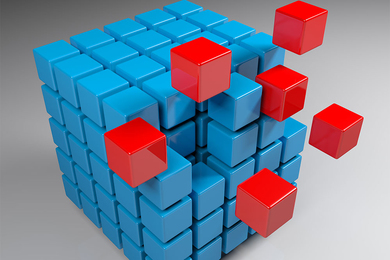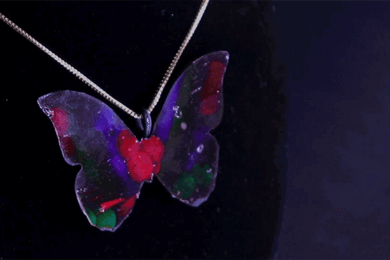Ken Gagné — by day, webmaster at MIT Medical — does a whole 'nother gig in his spare time. He's the cohost of the monthly Open Apple podcast and last year launched the MS Challenge Talk for the National Multiple Sclerosis Society, a series of audio interviews to inspire people training for the MS Challenge Walk.
Gagné recently gave a presentation, Podcasting 101: Everything You Need to Know, to communicators in MIT's Social Media Working Group. This article covers some of the highlights of that talk, which focused on audio podcasts. (Video podcasts are out there, but much lower on the totem pole.)
According to Gagné, this is a great time to speak out on your favorite topics: podcasting, which faded in popularity years ago with the rise of YouTube, is experiencing a second wave of interest. People can and do listen to podcasts while commuting in the morning, cooking dinner or taking a road trip.
What is podcasting?
Podcasting is the combination of two technologies: an audio file, such as an MP3 file, and a delivery mechanism, usually a "pull" technology such as RSS (explained in the video RSS in Plain English). Podcasts can be many things: radio shows, such as This American Life; tutorials, such as language learning; music, such as New Classical Tracks; interviews, such as MIT Press Podcasts; reports and commentaries, as in 60-Second Science from Scientific American. In short, there's a world of podcasts to explore.
iTunes is the primary delivery mechanism for podcasts. That said, you don't need iTunes or an iPod, iPad, or iPhone to access them. You can download and listen to podcasts on your Windows laptop, your Samsung Galaxy Android phone, almost any device that plays digital sound files.
Apple does not own propriety rights, copyright, or the technology associated with podcasts. Truth be told, iTunes doesn't store the podcasts, it just points listeners to the websites where they are posted. When people subscribe to your podcast through iTunes, new episodes get delivered to them automatically.
For insights on finding and playing podcasts, see Apple's Tips for Podcast Fans.
Why Do Podcasting?
Relatively speaking, there aren't that many podcasts online. Compared to 181 million blogs vying for your attention, there are only 200,000 podcasts. Most podcasts are not monetized and many are aimed at niche markets, two factors that also limit competition for listeners.
If you decide to give podcasting a try, here are some considerations to keep in mind:
While professional sound studios are stocked with sophisticated equipment, you can make decent-sounding podcasts with your laptop and its built-in microphone. If you're recording online interviews, you'll also want a pair of headphones so that you can hear the person without your mic picking up their voice. (Remember, separate tracks make for cleaner editing.)
If you want to take recording to the next level, the basic hardware is affordable. You might want an external mic with a shock mount so that if you accidentally bump it, it doesn't pick up the vibrations from the table. Similarly, a pop filter that you place in front of a mic eliminates "plosives" – the spikes in sound created when voicing the letter "p".
If you are using a landline to record phone conversations, you can buy an adapter that goes between the base and handset and enables you to hear the conversation while a separate line connects to your computer or MP3 recorder.
If you're recording in person, Gagné suggests using a digital recorder with a USB port. Some of these recorders have removable memory cards.
Software
Gagné's recommended software for online recording are Mac-based, since that's the platform he uses. His top two contenders are Audio Hijack Pro and WireTap Studio. He finds the pricier WireTap Studio a bit easier to set up and use.
For editing audio files, Gagné highly recommends Audacity, which is free, open source and cross platform. His Open Apple cohost uses Windows to record; using Audacity, they can exchange and edit files without conversion difficulties.
When you want to publish your podcast, both WordPress and Drupal offer RSS right out of the box, no plug-ins or modules needed. This RSS feed can then be submitted to podcast directories such as Apple's iTunes.
Other resources
You may want to use background music in your podcasts, especially during the intro and at the end. Gagné recommends getting royalty-free music from the Free Music Archive (FMA) and Overclocked Remix. Both are free as long as you're not selling your show. FMA has more variety and you can filter by genre (jazz, pop, techno). Overclocked Remix takes popular tunes and makes them sound like they were generated from a computer.
Regarding podcast analytics, iTunes doesn't provide any, but you can get them by signing up for a free service. Gagné uses blubrry, which keeps track of how many times a podcast is downloaded over what period of time. It doesn't tell you who downloaded the podcasts or how long they listened to it.
If you're looking for on-campus recording services, MIT's Audio Visual Services has a sound studio and can record on site at lectures and events. In addition, they can clean up recordings you've made. All of these services are fee-based.
Promoting your show
To promote your show, target a niche audience and then go to those communities. Gagné's community, the Apple II crowd, is fairly small — maybe a thousand people on FaceBook and Google+. He posts about the podcasts on those community pages. He also reaches out to podcasters who cover similar topics and asks them to plug his show.
You can set up your own Facebook, Google+ and Twitter pages, ask people to "like" them, and interact with your audience. There are also other podcast directories besides iTunes; do a search for them and then start submitting your show everywhere.
Wrap up
To view Gagné's complete presentation (a slideshow with voiceover), go to Podcasting 101 on MIT TechTV. For recent demographics about podcasting, check out the Slideshare presentation, The Podcast Consumer 2012, from Edison Research.
Questions about podcasting? You can contact Gagné at kgagne@mit.edu or through his web page.
Gagné recently gave a presentation, Podcasting 101: Everything You Need to Know, to communicators in MIT's Social Media Working Group. This article covers some of the highlights of that talk, which focused on audio podcasts. (Video podcasts are out there, but much lower on the totem pole.)
According to Gagné, this is a great time to speak out on your favorite topics: podcasting, which faded in popularity years ago with the rise of YouTube, is experiencing a second wave of interest. People can and do listen to podcasts while commuting in the morning, cooking dinner or taking a road trip.
What is podcasting?
Podcasting is the combination of two technologies: an audio file, such as an MP3 file, and a delivery mechanism, usually a "pull" technology such as RSS (explained in the video RSS in Plain English). Podcasts can be many things: radio shows, such as This American Life; tutorials, such as language learning; music, such as New Classical Tracks; interviews, such as MIT Press Podcasts; reports and commentaries, as in 60-Second Science from Scientific American. In short, there's a world of podcasts to explore.
iTunes is the primary delivery mechanism for podcasts. That said, you don't need iTunes or an iPod, iPad, or iPhone to access them. You can download and listen to podcasts on your Windows laptop, your Samsung Galaxy Android phone, almost any device that plays digital sound files.
Apple does not own propriety rights, copyright, or the technology associated with podcasts. Truth be told, iTunes doesn't store the podcasts, it just points listeners to the websites where they are posted. When people subscribe to your podcast through iTunes, new episodes get delivered to them automatically.
For insights on finding and playing podcasts, see Apple's Tips for Podcast Fans.
Why Do Podcasting?
Relatively speaking, there aren't that many podcasts online. Compared to 181 million blogs vying for your attention, there are only 200,000 podcasts. Most podcasts are not monetized and many are aimed at niche markets, two factors that also limit competition for listeners.
If you decide to give podcasting a try, here are some considerations to keep in mind:
- Think twice before doing live shows. Almost everyone stumbles over words from time to time, and guests may be especially nervous. There may be HVAC hum in the background or the sound of a fire engine driving by. If you want your podcast to sound smooth and effortless, you'll probably need to put in some time editing the audio tracks.
- By law, you need to get a person's permission — verbally or in writing — before recording them. For specifics, see Recording Phone Calls and Conversations.
- In-person interviews make it easier to establish rapport with your guests. The downside is that everything gets recorded on the same audio track, which makes editing more difficult — for example, if one of you sneezes while the other is talking.
- Online interviews, with host and guest in different locations, don't foster as much immediacy. On the plus side, each person can be recorded on an individual track, which makes for cleaner editing.
- If you're going to do a podcast on a regular basis, it helps to have a co-host. That way, you keep each other committed and on schedule. Gagné and his Open Apple co-host create a Google Docs spreadsheet of the topics they're going to cover in each podcast episode. They have regular categories, such as news, EBay, and notes. Each month, before the show, they populate these categories with content and associated links.
- Plan to record more audio than the show's final length (e.g., 45 minutes for a 30-minute show), since you'll be editing out noise, long silences, and extraneous chat. Do the introduction to the podcast last; only after the whole show has been recorded will you know all the topics that were covered.
- While editing audio is much simpler than editing video, it's still a major component of producing a podcast. Gagné estimates that it takes roughly four times a show's length to edit it, not counting recording time.
- After the first round of editing to clean up the sound, you may want to reorder the segments of your podcast for better flow.
While professional sound studios are stocked with sophisticated equipment, you can make decent-sounding podcasts with your laptop and its built-in microphone. If you're recording online interviews, you'll also want a pair of headphones so that you can hear the person without your mic picking up their voice. (Remember, separate tracks make for cleaner editing.)
If you want to take recording to the next level, the basic hardware is affordable. You might want an external mic with a shock mount so that if you accidentally bump it, it doesn't pick up the vibrations from the table. Similarly, a pop filter that you place in front of a mic eliminates "plosives" – the spikes in sound created when voicing the letter "p".
If you are using a landline to record phone conversations, you can buy an adapter that goes between the base and handset and enables you to hear the conversation while a separate line connects to your computer or MP3 recorder.
If you're recording in person, Gagné suggests using a digital recorder with a USB port. Some of these recorders have removable memory cards.
Software
Gagné's recommended software for online recording are Mac-based, since that's the platform he uses. His top two contenders are Audio Hijack Pro and WireTap Studio. He finds the pricier WireTap Studio a bit easier to set up and use.
For editing audio files, Gagné highly recommends Audacity, which is free, open source and cross platform. His Open Apple cohost uses Windows to record; using Audacity, they can exchange and edit files without conversion difficulties.
When you want to publish your podcast, both WordPress and Drupal offer RSS right out of the box, no plug-ins or modules needed. This RSS feed can then be submitted to podcast directories such as Apple's iTunes.
Other resources
You may want to use background music in your podcasts, especially during the intro and at the end. Gagné recommends getting royalty-free music from the Free Music Archive (FMA) and Overclocked Remix. Both are free as long as you're not selling your show. FMA has more variety and you can filter by genre (jazz, pop, techno). Overclocked Remix takes popular tunes and makes them sound like they were generated from a computer.
Regarding podcast analytics, iTunes doesn't provide any, but you can get them by signing up for a free service. Gagné uses blubrry, which keeps track of how many times a podcast is downloaded over what period of time. It doesn't tell you who downloaded the podcasts or how long they listened to it.
If you're looking for on-campus recording services, MIT's Audio Visual Services has a sound studio and can record on site at lectures and events. In addition, they can clean up recordings you've made. All of these services are fee-based.
Promoting your show
To promote your show, target a niche audience and then go to those communities. Gagné's community, the Apple II crowd, is fairly small — maybe a thousand people on FaceBook and Google+. He posts about the podcasts on those community pages. He also reaches out to podcasters who cover similar topics and asks them to plug his show.
You can set up your own Facebook, Google+ and Twitter pages, ask people to "like" them, and interact with your audience. There are also other podcast directories besides iTunes; do a search for them and then start submitting your show everywhere.
Wrap up
To view Gagné's complete presentation (a slideshow with voiceover), go to Podcasting 101 on MIT TechTV. For recent demographics about podcasting, check out the Slideshare presentation, The Podcast Consumer 2012, from Edison Research.
Questions about podcasting? You can contact Gagné at kgagne@mit.edu or through his web page.






